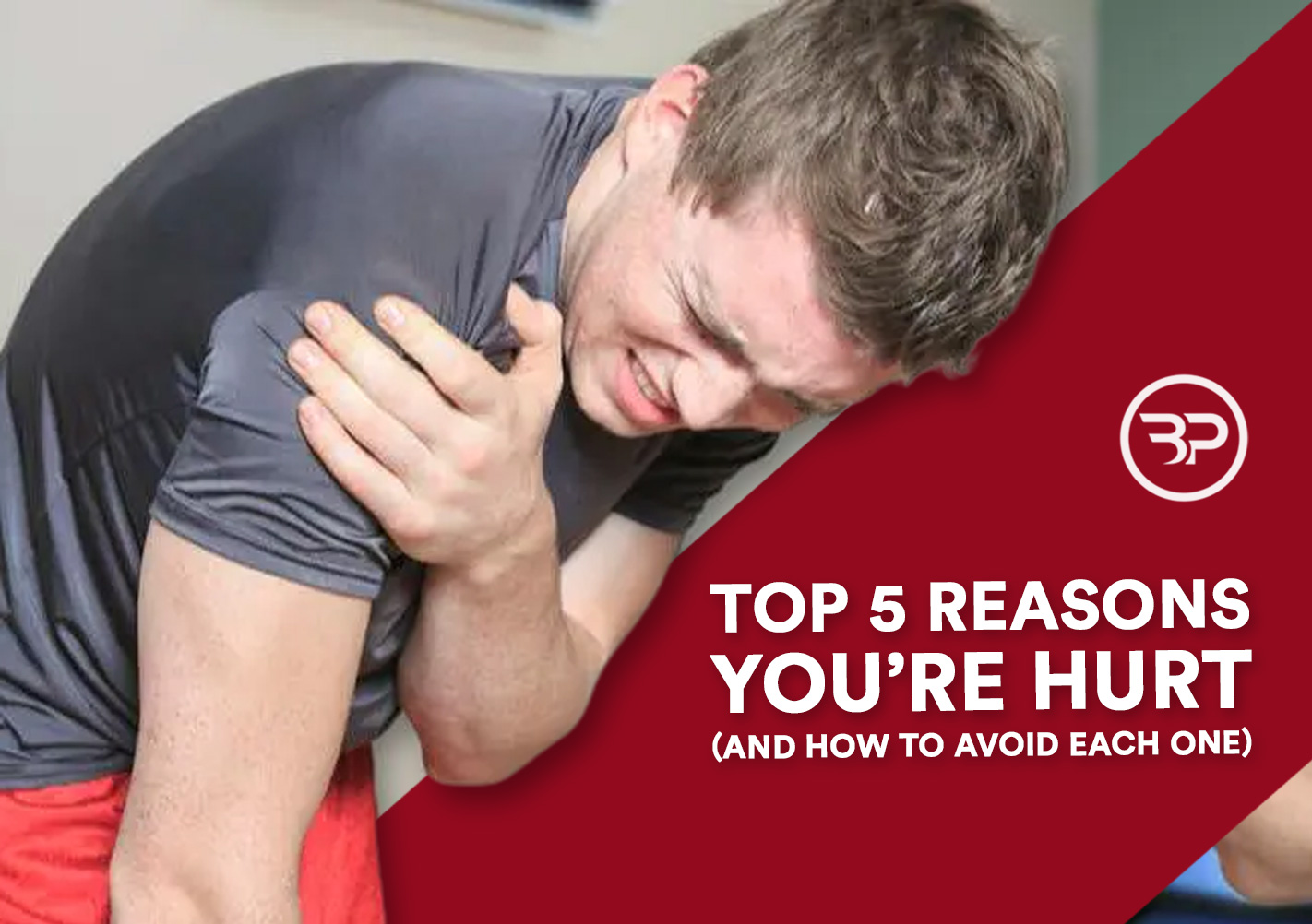Top 5 Reasons You’re Hurt (And How To Avoid Each One)
June 13, 2017
Guest Post By Linden Ellefson
When it comes to gym injuries, you roll the dice every with every visit.
What will hurt? Your shoulder? Your ankle? Your back?
It’s been months since you have sniffed a PR. You feel like after all the Yoga you’ve been doing, your body should feel somewhat better, right?
Nope. You are in near constant pain. It may be low level, but it won’t go away. And here’s what sucks most:
You have no idea how it started or if it will ever end. Maybe it will even get worse.
But you’ve gotten used to it.
The worst part is that it all stemmed from a couple of bad lifts in the gym. Now it hampers not only your gym experience but also your time at home with your kids.
But most gym injuries are pretty freaking preventable. And you kinda know it. But you’re still reluctant to change. After all, being stubborn got you pretty far, right?
Wrong.
You have carried “stubborn” too far. Now it’s hurting you — literally.
Time to change. Time to get rid of the pain. You might just save yourself thousands of dollars in chiro, sports medicine, or even surgical, expenses.
I explain all this and more in my free eBook 4 Killer Secrets To Getting Back in the Game. Download it for FREE here.
But for now, here’s what you’re doing wrong — and how to fix it.
1. You Don’t Warm Up Properly
Is your idea of a warm-up riding a bike for five minutes, doing a couple of arm swings and then hopping onto the bench or squat rack? No wonder you’re always hurt.
Confession: That used to be me. But I’ve since learned better. And so should you.
Proper warm up includes a few key things:
- Moving the joints that will be used during your training session
Low Lunges with a twist, Bear Crawls, and the Pike to Plank can all be used as total body joint movers to get the body ready for training. Here’s how Low Lunges are done.
Equally effective are
Bear Crawls
Pike To Plank
(Click on the links above to see demos.)
The keys to success are:
- Increasing local blood flow to the areas you’re going to train. This could be doing a few sets of 20 squats with just the bar, or doing push-ups and bear crawls before hitting the bench. Doing this will allow your body to rely on the muscles, not the joints and ligaments surrounding the muscles.
- Get core stability rockin’. Without a stable core, your hip flexors are going to be tighter than normal, your lower back will start to ache half way through your set of squats, and even your knees could feel it too. Get your core stable with a couple sets of dead bugs, and RKC planks, and you will be set to go.
- Telling your nervous system you’re about to lift some heavy weights. You can accomplish this by doing some medium height box jumps, hurdle jumps, or clap push-ups.
Bottom line: None of this requires hours and hours of warm up time. Some of the warm-up exercises can be built into your warm up sets for squat, bench and deadlift. But if you aren’t doing these four key things, then there’s a chance you will still be injured.
2. Focusing On The Wrong Mobility
Every program needs static stretching, dynamic stretching, foam rolling, and the occasional yoga session.
If the pain is still there, you are doing something wrong.
Your tight hamstring probably won’t be solved by doing endless hamstring stretches.
If your hip flexors are STILL tight, then foam rolling them for 45 minutes or stretching the crap out of them might not help all that much.
Bottom line: If you try all of the above and still find yourself in this situation where you have no idea how to fix it, find a qualified physical therapist who can tell you what is going on.
3. Lift Properly
As a trainer, I see people on the verge of injury from doing deadlifts wrong.
Every. Single. Dang. Day.
Almost every other week, I hear from my wife that she’s heard or seen someone performing a deadlift wrong. Now they are hurt.
Today, I saw someone with a back that was in complete spinal flexion doing a 405lb deadlift. It wasn’t too different from this right here.
Granted he is pretty strong and actually locks out. But I can guarantee you his back won’t feel real great tomorrow. Or maybe even the next week.
Actually, I doubt I’ll see him train his deadlift for the next month.
It doesn’t just happen with the deadlift, but we NEED to spend some time learning exercises properly!
If you are doing a deadlift, it should look very similar to THIS. Every time.
By the way, that’s a client of mine who is well into his 60’s. He’s doing great deadlifts that look exceptional. He has no pain. So much for the notion that deadlifts are just for 20-something guys with no better outlet for their energy.
Maybe right now due to mobility, a deadlift from the floor is impossible. That’s fine! There is no shame in training from blocks. I actually do the majority of my deadlifts and Olympic lift training off 25lb plates.
Maybe it’s about taking one step back to take five steps forward. Consider taking your deadlifts back to 315 lbs and crushing your form. Progress from there. When you get back to 405 your back won’t look like Quasimodo’s
Bottom line: Choose the right exercises and do them with excellent form. Then add weight in moderate increments. Your body will thank you.
4. Balance Your Training
Be aware of the importance of single limb vs. double limb movements.
For example:
– Train upper body AND lower body
– Train quads AND glutes
– Training Multi AND single joint exercises.
– Improve Cardio AND strength. If you’re a strength athlete, a strong cardio system will allow you to stay strong in the later sets without
Bottom line: Balance in your training program decrease injuries.
5. You Progress Too Quickly
Moderate increases over a lifetime are better than a huge increases over a few weeks.
Decrease risk by following a sensible training program.
Based on what I’ve seen in the gym and heard from clients, it’s amazing how few gym-goers have a real training program. Many seem to improvise every time they step into the gym.
This leads you to train based on feel and what you THINK you did last week. Not base your training on feel and the cold hard numbers, like an individual who cares about their workouts.
The Takeaway
Follow a training program that addresses the issues above.
Write it down. Track Progress.
You’ll be rewarded with consistent progress over months and years. That’s a better better approach that looking for big #gainz in a few weeks.
Start by getting back in the game. Discover how by downloading my FREE ebook 48 Killer Secrets To Getting Back in the Game. It might just change your life.
About The Author
 Linden Ellefson, is a Calgary, Alberta personal trainer and online coach whose work has been featured in Healthy Living, Heavy Lifting, The Personal Trainer Development Center and elsewhere. He loves good coffee, his Boston Terrier Taco, and good workouts. Most of all, he loves making his clients the strong, athletic beasts they were meant to be.
Linden Ellefson, is a Calgary, Alberta personal trainer and online coach whose work has been featured in Healthy Living, Heavy Lifting, The Personal Trainer Development Center and elsewhere. He loves good coffee, his Boston Terrier Taco, and good workouts. Most of all, he loves making his clients the strong, athletic beasts they were meant to be.








